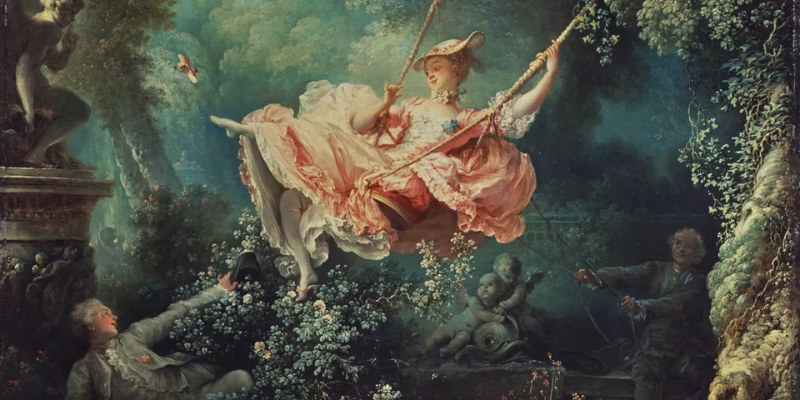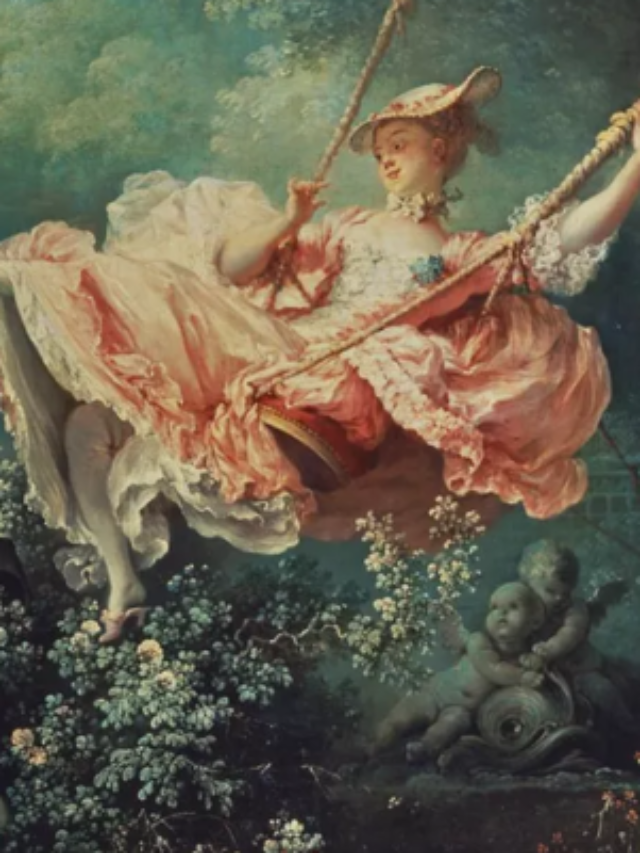If you’re somewhat into art or social media, chances are you might’ve stumbled upon the portrait of a girl in pink swinging in a lush field. The painting is titled The Swing or Les heureux hasards de l’Escarpolette by the painter Jean-Honoré Fragonard, and it is regarded as one of the most famous pieces of work in the Rococo style of art.
Rococo art, from the 1730s to the 1780s, derives its name from the French “rocaille,” signifying rubble or rock. This phrase refers to the spiral designs found in grottos and fountains during this time period, which are reminiscent of pebble or shell work. Rococo art represents a sense of frivolity and complex beauty and is characterized by depictions of nature, asymmetry, ornate details, and vivid pastel colors. Famous pieces of art, buildings, and fashions from the Rococo era are included here.
Rococo Architecture
The Rococo style started as a trend in architecture that later on filtered down to other art scenes of the era. Following are some examples of Rococo-style architecture:
1. Brühl Palace
Brühl Palace was located in Warsaw, Poland. Built in 1642 by Joachim Daniel von Jauch, the palace stood as the epitome of Rococo architectural grandeur till pre-World War II. The palace however was demolished by Germans in 1944 following the Warsaw uprising.
2. Charlottenburg Palace

French Rococo and Italian elements are combined in Johann Friedrich von Eosander’s 1699 work Charlottenburg Palace. Friedrich I of Prussia ordered it, and as time went on, it grew, adding wings and an orangery. The palace, embellished by artists such as Jan Anthonie Coxie, came to represent the pinnacle of regal luxury.
3. Amalienburg
Located in Munich’s Nymphenburg Palace complex, Amalienburg is an 18th-century hunting lodge. With its asymmetrical design, elaborate interiors, and pastel colors, it is a perfect example of the Rococo style, having been designed by François de Cuvilliés. The lodge’s allure is found in how well it combines lavish design with the natural world.
4. Catherine Palace
A fine example of Rococo architecture is found in Tsarskoye Selo, close to St. Petersburg, Russia. It is called Catherine Palace. Constructed during the 18th century, it features rich decorations, ornate goldwork, and fine moldings. The asymmetrical architecture, elaborate façade, and elegant interiors of the palace, which perfectly capture the majesty of the time, are all examples of its Rococo style.
5. Würzburg Residenz
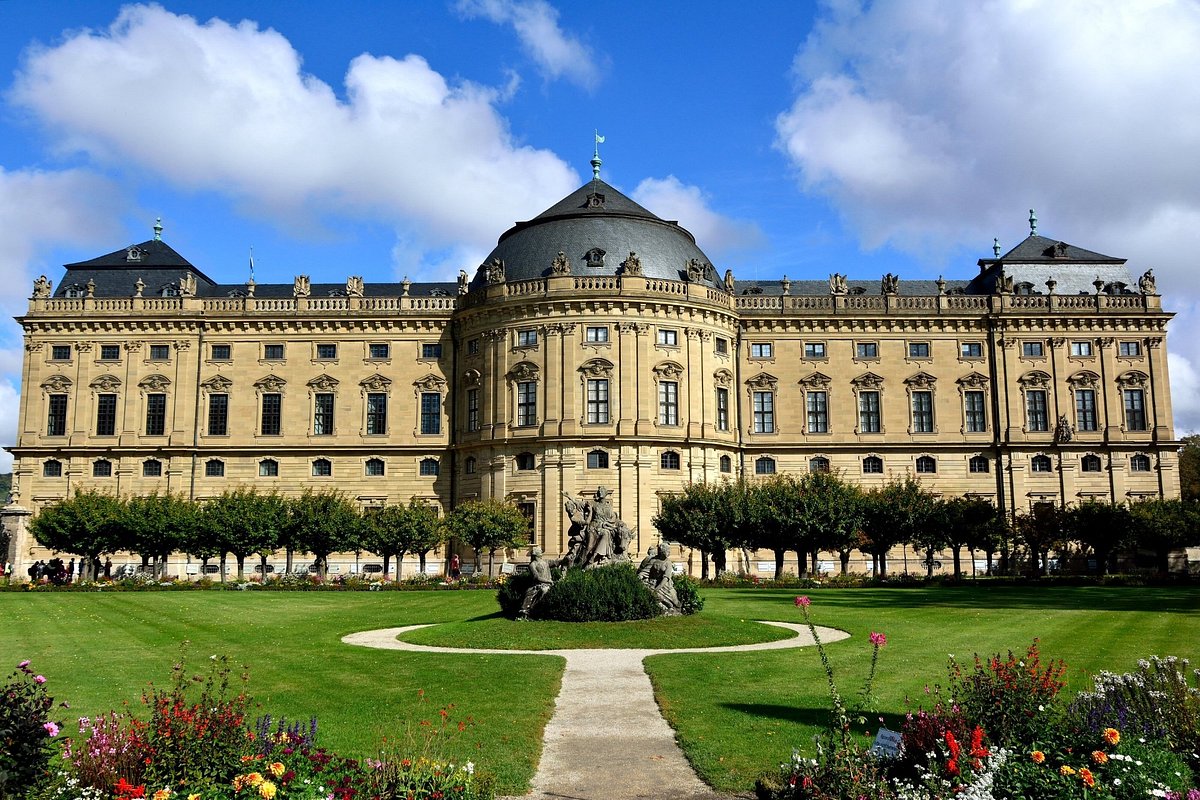
Germany’s Würzburg Residenz is a UNESCO World Heritage monument and an example of Rococo design. It was created in the eighteenth century by Balthasar Neumann and features lavish embellishments, intricate stucco work, and asymmetrical layouts that epitomize the flamboyance of the Rococo style. The magnificent Imperial Hall and White Hall are the pinnacles of Rococo splendor.
Rococo Fashion
/https://tf-cmsv2-smithsonianmag-media.s3.amazonaws.com/filer/8c/a3/8ca3c860-ffb1-4a89-8132-27c521f79e54/pompadour.jpg)
During the Enlightenment, France underwent a cultural revolution during the Rococo era that valued reason overpower. The mistress of Louis XV, Madame Pompadour, was instrumental in creating the Rococo style, which is distinguished by pastel hues. Then, Marie Antoinette rose to prominence in fashion, renowned for her stunning extravagance.
Influential fashion designers rose to prominence and vibrantly illustrated periodicals spread the newest trends. The large panniers, corsets, and low necklines of the era gave women a new silhouette. Various dress styles arose, such as the robe à la française, robe à l’anglaise, and Watteau gown. The chemise à la reine worn by Marie Antoinette represented the growing emancipation of women.
Ladies’ shoes got more delicate, and hairstyles changed from form-fitting to ornate wigs embellished with sculptures and feathers. Men dressed in French-style habit variations, accessorizing with tricorne caps and ornate waistcoats. As knee breeches became unpopular and rebels donned the tricolor, the French Revolution introduced fashion into politics.
Aristocrats and bourgeoisie alike, as well as excess and a desire for simplicity, defined the Rococo era, which had a wide range of effects on fashion. Even though the movement was put to an end by the French Revolution, its concepts persisted for decades and reflected a distinctive fusion of opposing aspects in fashion.
Rococo Art Paintings
There are several artworks apart from The Swing that defined the Rococo art movement. Following are some of them:
1. François Boucher, Triumph of Venus

The Rococo painting “Triumph of Venus” (1740) by François Boucher shows the goddess Venus encircled by frolicking angels. The composition, which is executed with Boucher’s characteristic grace and sensuality, depicts a lavish, pastoral landscape and demonstrates his skill at capturing minute details and the opulent aesthetics of the 18th-century Rococo style.
2. William Hogarth, The Settlement

Part of a series that shows a tragic arranged marriage, is William Hogarth’s “The Settlement” (from “Marriage A-la-Mode,” 1742–1744). By depicting the repercussions of marital errors, the artwork parodies the social mores of the day. This narrative artwork reflects Hogarth’s deft observational and moral commentary, as well as his skilled use of imagery to convey a story.
3. Thomas Gainsborough, The Blue Boy
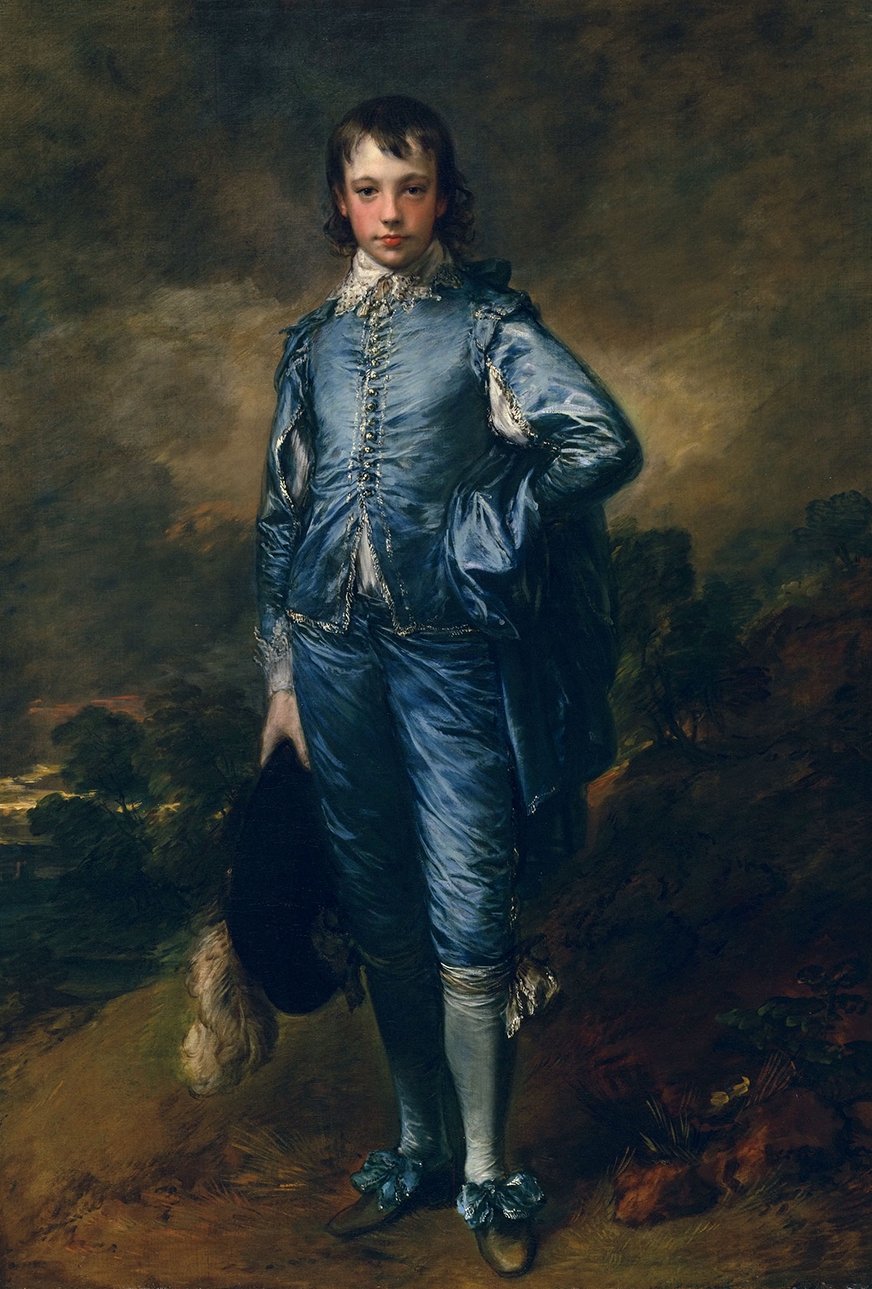
The 1770 portrait “The Blue Boy” by Thomas Gainsborough is a prime example of 18th-century portraiture. The child in the painting is dressed in a blue satin costume and exudes refinement and grace. The essence of Rococo portraiture is captured by Gainsborough’s use of color, brushwork, and attention to detail, demonstrating his mastery of the medium.
4. The Brown Odalisque by François Boucher

François Boucher’s scandalous 18th-century painting “The Brown Odalisque” features an exoticized female figure. Sensual and provocative, the image of a reclining naked woman with Eastern elements caused debate. Boucher’s artwork challenges the social customs of the Rococo era and reflects the preoccupation with the exoticism of the time.
5. Pierrot, by Jean-Antoine Watteau

The well-known painting “Pierrot,” originally called “Gilles,” was created by Jean-Antoine Watteau. It depicts a sad Pierrot, a traditional Commedia dell’arte character, and was created in the early 1700s. The character’s theatricality is expertly captured in the artwork, which showcases Watteau’s skill in capturing dramatic and moving moments in the Rococo style.
Rococo Artists
Given below are some of the genre-defining artists of the Rococo era:
1. Francois Boucher

French Rococo painter François Boucher is renowned for his opulent, seductive, and endearing creations. He was a well-known artist in the eighteenth century who painted at the court of King Louis XV. Boucher demonstrated his command over Rococo aesthetics in his paintings, which frequently contained mythological subjects, pastoral scenes, and romanticized representations of everyday life.
2. Thomas Gainsborough

Throughout the 18th century, Thomas Gainsborough (1727–1788) was a well-known English painter of landscapes and portraits. Renowned for his skill in portraying natural settings and attitudes, Gainsborough’s paintings, such as “The Blue Boy” and high society portraits, highlight his unique style and important contributions to Georgian art.
3. William Hogarth

William Hogarth (1697–1764) was a well-known humorist, painter, and engraver from England. Well-known for his narrative paintings, he cleverly and socially commented on events from modern life. His series “A Harlot’s Progress” and “Marriage à-la-mode,” two of Hogarth’s most well-known creations, demonstrate his astute observation and critical viewpoint on 18th-century society.
4. Giovanni Battista Tiepolo
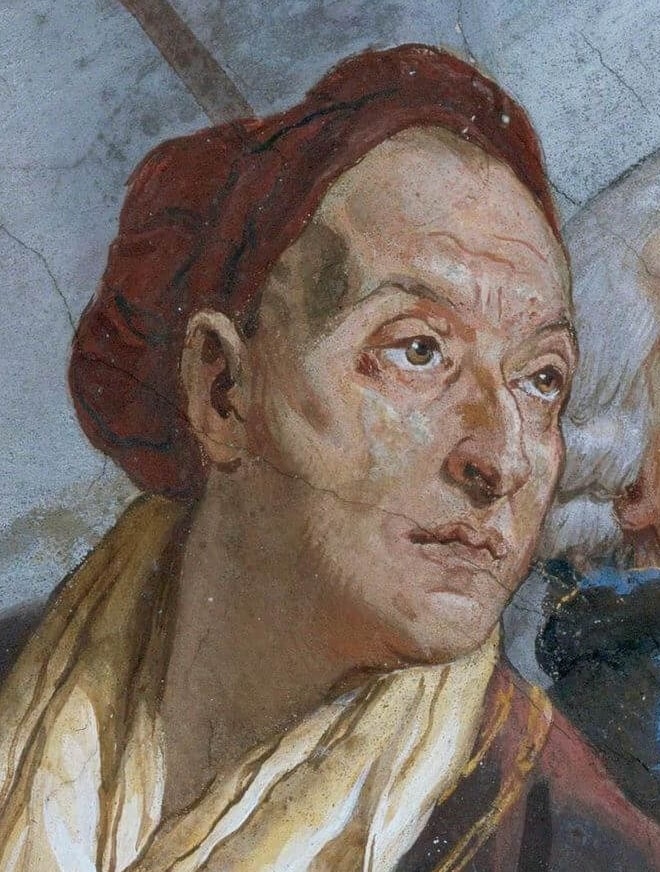
Giovanni Battista Tiepolo was an Italian Rococo painter and printmaker who lived from 1696 until 1770. Across Europe, churches and palaces have displayed his renowned frescoes. Bright colors, dynamic compositions, and a theatrical quality define Tiepolo’s work.
5. Antoine Watteau
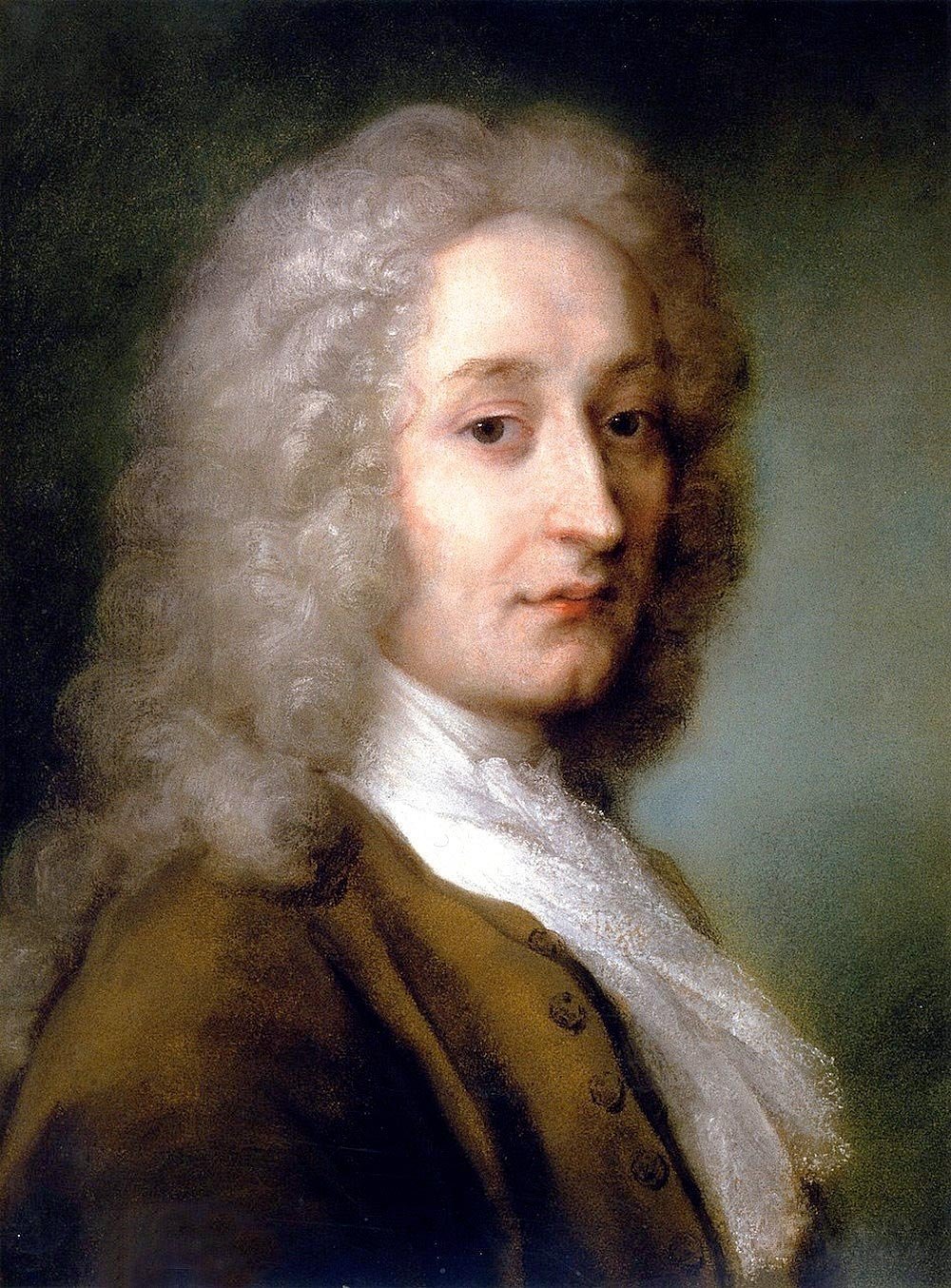
French Rococo painter Antoine Watteau (1684–1721) is renowned for having contributed to the creation of the fête galante genre. His paintings, including “Pilgrimage to Cythera,” are distinguished by their bright colors, poetic setting, and deft brushwork. The paintings of Watteau had a great impact on French painting in the eighteenth century.
Rococo Furniture
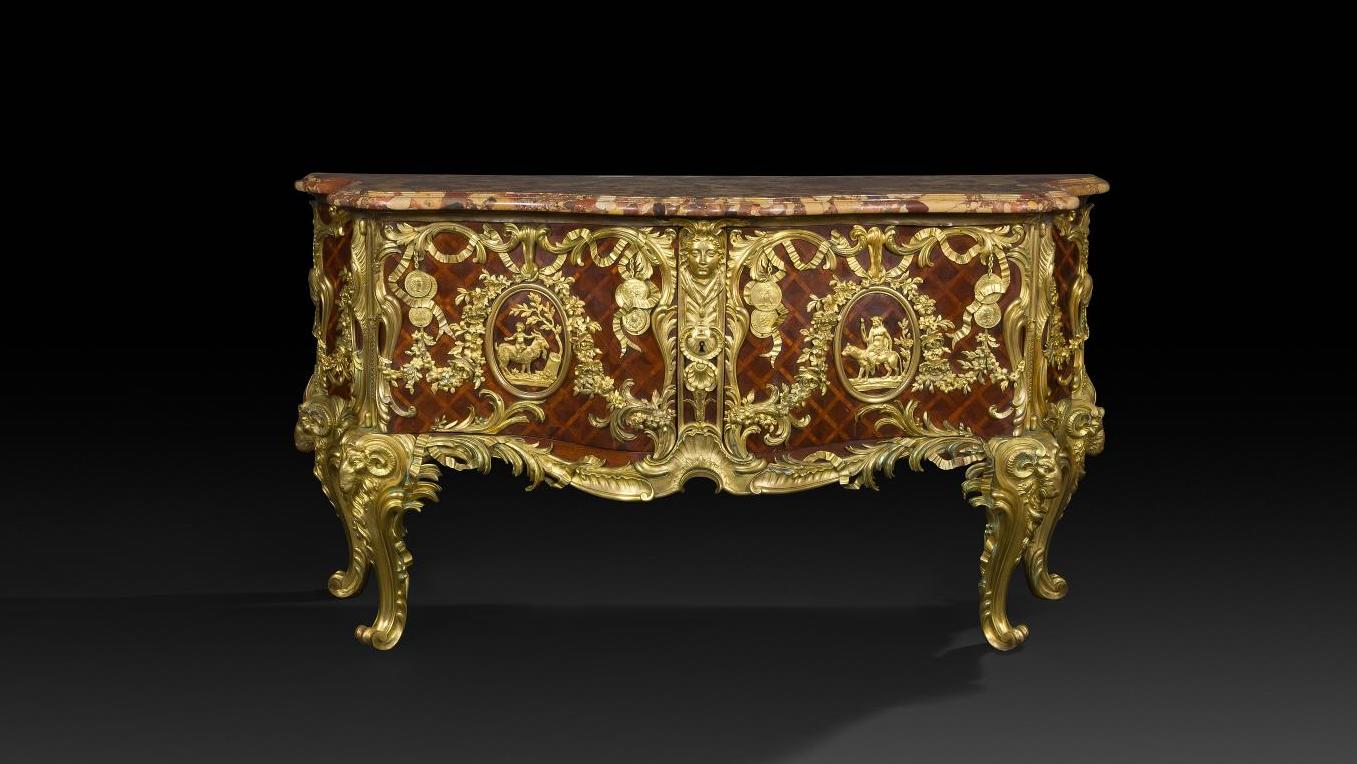
European interior design was greatly influenced by French furniture in the eighteenth century. A lighter, more curved design was adopted in France during the Régence, which is the term used to address the transition from Baroque to Rococo. A significant figure in this time was the ébéniste Charles Cressent, who emphasized the use of ormolu mounts in furniture design. Asymmetrical designs characterized the Rococo style, which originated around 1735 and was inspired by the fantastical aspects of the Versailles gardens. Juste-Aurèle Meissonier’s contributions, which included ornate embellishments such as C-scrolls, floral motifs, and Chinese-inspired features, were crucial in forming the Rococo style.

Around 1720, mahogany began to supplant walnuts in furniture made in England, as architects such as William Kent embraced Classical form combined with Baroque decoration. Despite resistance, the Rococo style gained traction in England in the 1740s, with pattern books and Thomas Chippendale’s influential “Gentleman and Cabinet Maker’s Director” popularizing the style. In England, the Rococo style continued into the 1750s and 1760s, when Chippendale adopted features of French rocaille. In England, the Gothic style also made a comeback, influenced by Chippendale’s designs and Horace Walpole’s mansion.

Around 1750, the American colonies saw a change in furniture styles due to the growing popularity of mahogany and the impact of Rococo finishing from Chippendale’s models. While English designs were more large and ornate, the colonial Chippendale style preserved the previous cabriole charm.
References:
- Studio Binder- What is Rococo Art — Style, Artists & Famous Works Explained
- History of European Fashion on WordPress- Rococo [ruh-KOH-koh]: florid or excessively elaborate
- Britannica- 18th century: The Rococo Style
- Artsper Magazine- The 10 Rococo Artworks You Should Know
- Artsy-10 Artworks That Defined the Rococo Style
- The Arch Space- Rococo Architecture – An Exquisite Architecture Of Dramatic Energy
- Architecture of Cities- Top 15 Examples of Rococo Architecture
Read Also:
Beyond the Blues: Thomas Gainsborough and The Blue Boy Painting.

